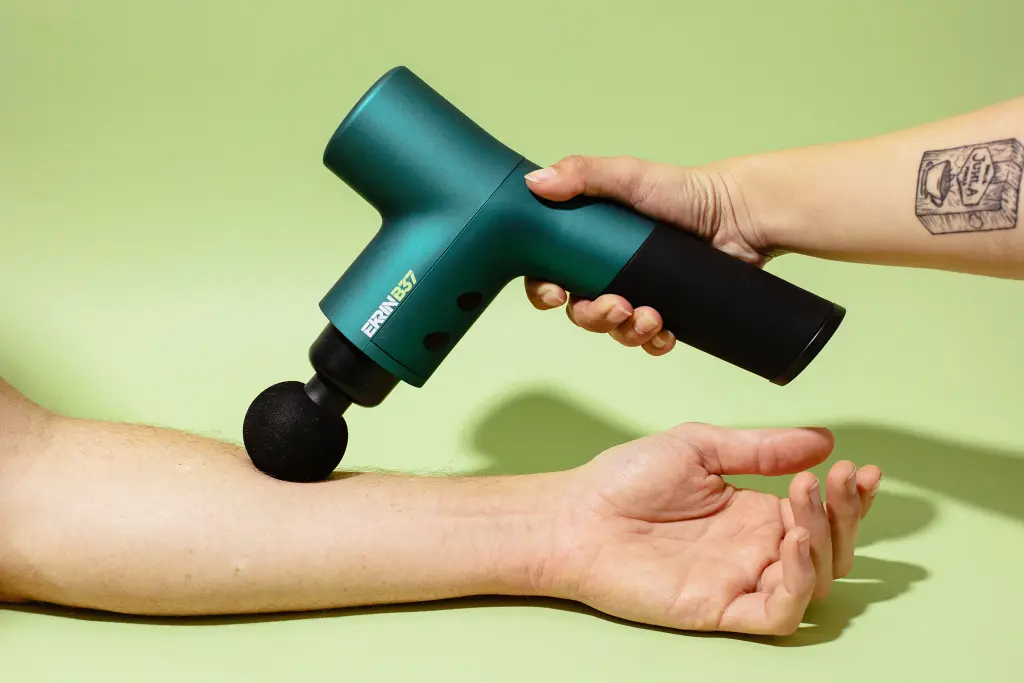Fitness and Training
What is a Massage Gun, and Why Use One?

Massage guns are more popular than ever. Celebrities, professional athletes, and fitness influencers alike rave about their benefits. Can they help up your fitness game, too? Here’s everything you need to know about when massage guns help, whom they might benefit, and how to use one if you decide to try it out.
What Is a Massage Gun, and Why Use One?
Massage guns (sometimes called “percussive massage treatment” or “vibration therapy”) are portable, handheld devices that look like a power drill and, in some cases, sound like one. They’re almost always wireless — most use a rechargeable battery — and they come with interchangeable attachments.
When the massage gun is placed on your muscles and turned on, the attachments vibrate or “percuss” at a high frequency and low amplitude of movement. Advocates claim that this promotes recovery from workouts and improves overall performance while reducing muscle soreness.You can use a massage gun whenever you’re looking to relieve some muscle tension, but it may be especially beneficial to use after a workout to promote recovery with reduced muscle soreness,” says Leada Malek, DPT, SCS, a sports physical therapist in San Francisco who’s board-certified through the American Board of Physical Therapy Specialists.
While Dr. Malek says the evidence is scant to conclusively link training benefits with massage guns, there is research to support the two modes of therapy that are behind the percussive massage treatment of massage guns. Those are: massage, a treatment in which your muscles are being kneaded and manipulated by another person; and vibration therapy, which involves placing a vibrating device on certain parts of your body.
“Massage can reduce tension in muscles and impact flexibility, reducing muscle stiffness, increasing blood flow, and decreasing muscle soreness,” Malek says. And there is some evidence that vibration therapy can have the same effect as massage therapy in terms of limiting delayed onset muscle soreness (the tightness and achiness you feel a day or two after a tough workout).Massage guns do similar things as massage, but the way they go about it is different,” Malek says. They offer a similar effect as foam rolling and massage. Which you choose may depend on personal preference.
Foam rolling uses myofascial release to decrease muscle tension. Fascia is the connective tissue that surrounds muscles, blood vessels, and nerves. For various reasons, fascia can get tight, even inflamed. When that happens, your ability to move can be hampered. Yet the gentle to moderate sustained pressure you apply with a foam roller can help tight areas of the body relax or release, Malek says.
You might get similar effects by holding a massage gun to one area, but it doesn’t qualify as myofascial release because of its rapid, percussive nature, Malek says.
Static stretching, on the other hand, uses slow, sustained stretches on a muscle to promote relaxation and reduce feelings of muscle tightness, and like foam rolling, it has more research to support its benefits, Malek says. (Note that this effect tends to be the case post-workout, but not typically as part of a pre-workout warmup.)
For some people, stretching may be more relaxing because of the nonpercussive impact on the muscle, Malek says. And because you don’t need equipment, it’s more convenient.
Source: everydayhealth
-

 Mzansi Celebs2 weeks ago
Mzansi Celebs2 weeks agoBerita Pays Tribute to Late Hugh Masekela
-

 Mzansi Celebs2 weeks ago
Mzansi Celebs2 weeks agoLegendary actor Chris Bra Spokes April has died
-

 Mzansi Celebs2 weeks ago
Mzansi Celebs2 weeks agoBoity Dragged For Not Being Invited to Cassper Nyovest’s Wedding Ceremony
-

 Mzansi Celebs2 weeks ago
Mzansi Celebs2 weeks agoPrince Kaybee’s Former Girlfriend Zola Ayabulela Mhlongo Joins Somizi on Metro FM
-

 Mzansi Celebs2 weeks ago
Mzansi Celebs2 weeks agoActor Sello Maake Ka Ncube loses money after divorcing his wife of three years
-

 Mzansi Celebs1 week ago
Mzansi Celebs1 week agoWatch – Skomota Reveals That His Wife Is Pregnant
-

 Mzansi Celebs1 week ago
Mzansi Celebs1 week agoNomfundo Moh says she is not doing gospel
-

 Mzansi Celebs5 days ago
Mzansi Celebs5 days agoMoses Tembe Opens Up After 3-years Of His daughter Anele Nelli Tembe’s Death


























